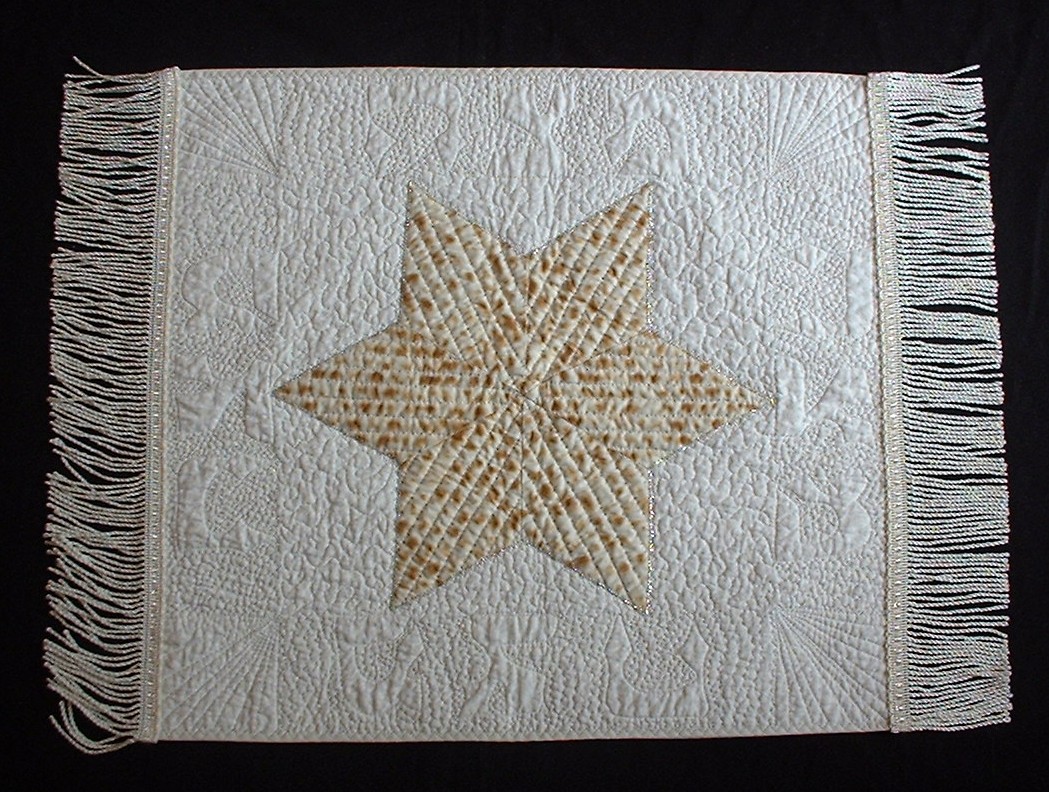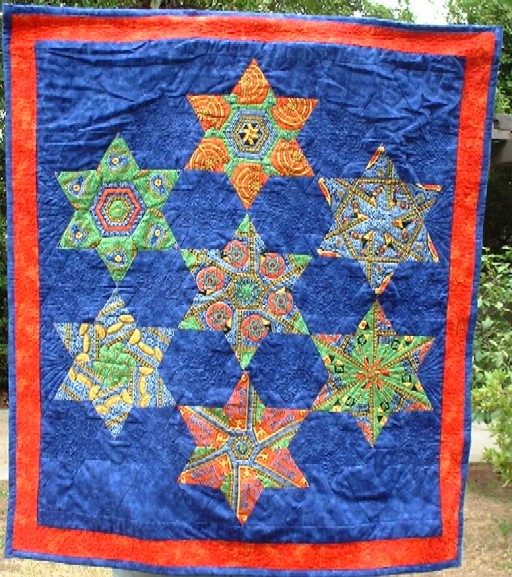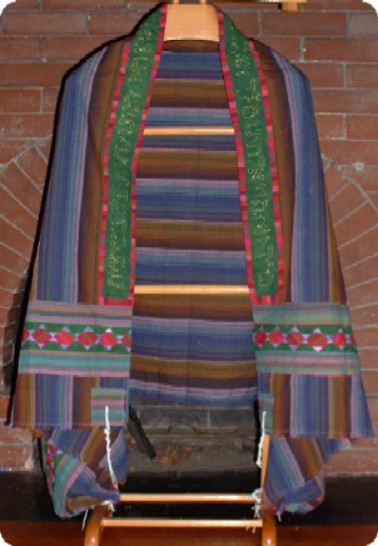When I
start thinking about design for any Jewish quilt project, the first option
that I consider is something that involves a six-pointed star. I can't help
myself.
First, there's the history. It's not the oldest Jewish symbol (the
seven-branched menorah is far older), but it has deep roots, going back to
about the 2nd Century (archeologists found it adorning the ruins the
famous Capaerneum synagogue from that era, on the Sea of Galilee---along
with menorahs, five pointed stars and---believe it or not---swastikas.). In
modern times, the star is powerfully evocative of our history, and of
sacred space.
And in the brief-by-comparison history of
American pieced quilts, the six- pointed star also has a noble history.
Traditional patterns like Baby Blocks, Tumbling Blocks, Seven Sisters,
Grandmothers' Flower Garden, Mariners' Compass, and others are based
on the shape.
If you make several stars, the arrangement
can be very simple but satisfyingly symmetrical (if symmetry is your
thing)---as in the Seven Sisters arrangement (a central star with six more
stars around it, touching points---see figures 3 )---or just thrown
around in a whimsical way (as in figure 2).
Perhaps the most exciting aspect of this design is its potential for
depth and/or motion. In a solid color, a six-pointed star is pretty
static. But if all the points contain symmetrical patterns, either printed
or pieced, and/or if the colors and values are arranged carefully, these
stars can start to pulsate, and spin, drawing the eye in and out again . Thanks to modern quiltmaking shortcuts and tools,
making kaleidoscopic stars like this is now ridiculously easy, and can be
accomplished quickly by someone with the most basic quilting skills .
Even more exciting is the potential for depth. Traditional six-pointed
stars are traditionally composed of 60 degree triangles. Depending how you
arrange the color values (dark and light) on those triangles, you can create
3-D illlusions, with cubes and stars appearing to jump in and out of the
quilt's surface. The traditional Tumbling Blocks design is the best known,
but infinite variations are possible.
In short, every six-pointed star quilt can be completely different from
every other. Graphically, I find this design potential sublime, thrilling,
even....spiritually uplifting! (Good choice, ancestors!)
What's slightly less thrilling is the fact that, as traditionally
constructed in fabric, six-pointed stars against a background have a set-in
Y shaped seam. That is a serious pain in the neck. If careful assembly of
dozens of perfectly accurate seams, each of which requires massaging fabric
against its natural instincts, doesn't frighten you as much as it frightens
me, you can skip the next several paragraphs.
The good news: Some of the greatest minds of quilting have tackled this
problem, and come up with some fun, fast and easy approaches to accurately
assemble complex-looking star designs. Some of the best short cuts (as well
as the long cuts) that I've found are listed below.
THE EASIEST
MAGIC STAR 6 by Mace McEligot
This totally innovative approach is by far the fastest, easiest, most
flexible and interesting way that I've found to create kaleidoscopic
six-pointed stars out of fabric. Each star is a sort of fabric sculpture.
The system includes a template and a set of instructions, and
also---optional but worth it---a two-sided mirror, a point turner (if you
have a hemostat, you don't need this), and an idea book (If you buy
everything, it will set you back about $30). You should own a rotary cutter
and a self-healing cutting mat (but you could get by with a marking pen and
sharp scissors). First, you slide the mirrors around on a piece of fabric,
til you find a design you like. Then, you place the template, made of
heavy-duty plastic, to the desired location, and cut out 6 identical diamond-shaped pieces. Then sew one side of the diamond to the
other, and turn inside out. Do the same for all 6 pieces, seam all six
pieces together (just straight stitching), and---voila!
There you stand, holding a cool little Jewish frisbee! Which won't
damage framed art ! Actually, it's a kaleidoscopic 6-pointed star which is
neatly finished all around the edges, with points backed for an inch or so.
It's ready for a fast hand or machine applique, to one large piece of
fabric, if you like. I used matzoh fabric with this system to make a simple
matzoh cover ( Figure 1). If you create a lot of stars, you can make a quilt
that's elegant for a wedding, or use fun and funky juvenile fabrics to make
a quilt for a baby. (figure 2.). Since the
top third of each star point is backed, I was able to create flaps with
surprises underneath on 'Raining,'---the star at the lower right even hangs
over the edge of the quilt.
Figure 3, made by Sue Feinberg, could have been
made using the system above. But it was actually a Stack and Whack
(see below) .
There's one downside to this system: it may be difficult to achieve the
mathematical precision that you can with a more traditionally pieced quilt.
It's hard to make the points absolutely perfect and flat. If you care
deeply about the absolute perfection of your points, keep scrolling down.
Otherwise, I recommend this system without reservation. It must be
ordered from the inventor, a delightful woman named Mace McElligot at Mace
Motif, 106 Manito Rd., Manasquan, NJ, telephone 908 223 4434. At this
writing, she did not have a website. Her Magic Star 6 book(TM) has lots of
good ideas, including one quilt that uses 6-pointed stars as flowers,
climbing a trellis---it would make a particularly nice, fast,easy huppah.
ADVANCED BEGINNERS AND BEYOND
STACK AND WHACK by Bethany Reynolds
To pull this off, you need a copy of the book "Magic Stack and Whack Quilts,
by Bethany Reynolds (American Quilters Society, 1998), which is still widely
available in quilt shops and bookstores. When she wrote this book, I don't
think Bethany Reynolds realized she might become heaven's gift to Jewish
quilters in a hurry. Stack and Whack is a ridiculously fun and
serendipitous way to spend an afternoon, in which you buy a half-dozen or
so yards of one interesting large-motif print fabric; cut it into several
identically-patterned strips; cut those strips into triangles; and sew
together the triangles---straight stitching only--- into kaleidoscopic stars
(or hexagons, or both). You have very little idea beforehand what your
stars will look like. Next thing you know, you got yourself an amazing
quilt that looks like you are a genius who knew what you were doing! I
made an elegant blue-white-and-gold huppah for my first Stack and Whack
(It's in the July/August 2003 issue of Quilters Newsletter Magazine); my quilting partner Sue used a colorful Judaic fabric,
set against a deep blue and orange Moda marble fabrics, to make
the lively Chanukah wall hanging in figure 4.
If you have basic experience with quilting, a sewing machine and a
rotary cutter, and follow the book, it's not hard at all. If you are a total
quilting beginner, enlist a more experienced friend to help you. Your local
quilt shop may also offer Stack and Whack classes.
THE BEST OF BOTH WORLDS: Stack 6 layers of pattern-aligned fabric, the
way Bethany Reynolds shows you, then use Mace's tool to cut out the points.
Before you know it, you'll have a large pile of ready-for-applique stars!
FOR EXPERIENCED QUILTERS
SARA NEPHEW
When the day comes that you want to design your own 6-pointed-star
quilt, replete with fascinating optical illusions (or not), you will
discover that regular, square graph paper doesn't work--- you need an
isometric triangle grid graph paper to do it---a grid made of up 60 degree
triangles (available at art supply stores, and some quilt stores). And when
you start playing around, you will discover that the design possibilities
are truly infinite. Books could be written about them. And many have been.
By Sara Nephew .
Nephew has written a half dozen quilt books
featuring complex but relatively-easy-to-piece 6-pointed-star designs and
other designs, with both a contemporary and traditional look, based on
equilateral traingles.. They are all excellent, and each of the quilts is
more interesting, and exciting than the last.. Her patterns do
require a 60 degree quilter's template and rotary cutter. They involve
cutting and precision sewing of a lot of identical triangles and diamonds.
But there's a break (literally); in most of her patterns (and all of the
most recent ones), there are no set-in seams at all. She breaks the piecing
down to straight seams only, making accuracy much easier.
Her excellent titles---loaded with quilt designs that, imho, would
make great huppot, challah covers, wall hangings, etc.--- include
'Equilateral Triangle Patchwork,' Dover Books, 1986 (originally published as
'Quilts from a Different Angle' This is her first book on the subject, and
some of the quilts have set-in seams) 'Stars and Flowers, Three-Sided Patchwork' (Clearview Triangle, 1989) ( beautiful designs and
simplified piecing) and 'Sensational Six-Pointed Star Quilts.'
(slightly more complex than the quilts in Stars and Flowers, but no set in
seams). Her quilt tops can take four hours to piece and up---way up.
But they are worth it. They are magnificent. The
books are not a light reading project; it takes time to digest and
understand them.
Along with the books, she sell high-quality, reasonably priced,
well-marked precision templates . Enjoy her website at
www.clearviewtriangle.com. Her company phone number is 888 901 4151 or 360
668 4151, address 8311 180th Street, SE, Snohomish, WA 98296. You might just
get her on the phone. By the way, although her family is not Jewish, she
told me that her daughter married a Jewish person, and Sarah made the
stunning huppa, a picture of which appears in the
Sensational
book and my article in the July/August QNM.
Another quilter with a simplified construction approach that's simliar
to Nephew's is Sharyn Squier Craig, whose book, Pyramids Plus (Chitra
Publications, 1997) also features lots of interesting triangle-based
6-pointed star and optical illusion quilts built on an isometric grid. Her
piecing system also avoids Y seams. It's a rotary cutting system. Her
approach either requires that you buy a 60 degree quilters rule, or a
plastic triangles from the stationary store (with 30-60-90 degree angles ).
Similarly, check out :
Poster, Donna, 'Stars Galore and Even More: Speed Cut Quilt Designs Using
Hexagons and Octagons' (Chilton, 1995).
Johanna, Barbara, 'Barbara Johannah's Crystal Piecing' (Chilton, 1993)
PAULA NADELSTERN
If you are a careful, patient person, you have a lot of time, and ambition,
and a lot of experience with quiltmaking---or, if you just want to gape at
incredible beauty--- go directly to Paula Nadelstern's books. Her astounding
quilts appear in Kaleidoscopes & Quilts (C&T Publishers, 1996), and the
latest , and Snowflakes & Quilts (C&T, 2001). See her work at
http://www.paulanadelstern.com/. She has created some of the
most dazzling 6-pointed star design quilts of all time.(Kaleidoscopic IV,
The Crystal Canopy, is a huppa). These are labor
intensive approaches---each star point is meticulously graphed and
foundation pieced, using specialized tools. Yet still leaving room for
serendipity---if you follow her approach you'll be in for some wonderful
surprises. They are truly masterpieces. If and when my children and I grow up, I want to be
her. An astonishing huppa she made is in the July/August 2003 QNM.
|
|

Fig. 1. Matzoh cover. The central star is pieced from matzoh fabric (see
Resources ) using Mace McElligot's Magic Star 6 (TM) tool.

Fig. 2. Raining Cats and Dogs, a baby quilt. Sorry this scan is so fuzzy, but I think you can get the idea. I cut out stars from different cat and dog fabric,using the Magic Star 6 (TM) tool. I appliqued the stars to a background pieced from (starting at the top) dogs in space, white dots on black, clouds on blue skies, then dogs among flowers at the bottom. Some of the stars overlap the edges of the quilt, and a few star points are flaps with surprises underneath.

Fig. 3. A
Hanukah quilt made by my quilting partner Sue Feinberg. Sue picked the
colors and fabric, and followed directions found in Bethany Reynolds'
Stack and Whack book (see Resources or below). .

Fig. 5. A tallit case pieced from vintage necktie fabrics. The star is traditionally pieced.

Fig. 6. Tallis with pieced stripes and machine-embroidered atarah. |





